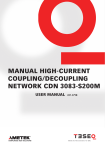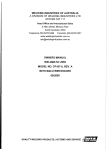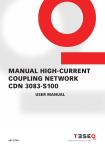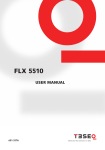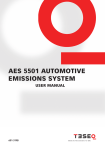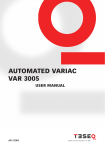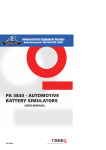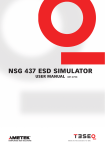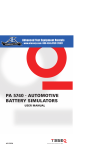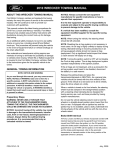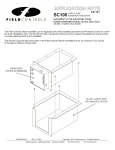Download 601-332A - CDN 3083-S200N User Manual english.indd
Transcript
1 manual high-Current coupling/decoupling network CDN 3083-S200N User Manual 601-332A manual high-Current coupling/decoupling network CDN 3083-S200N User Manual Manual high-current coupling network CDN 3083–S200N contentS 1. Explanation of the symbols used in this manual 2. Safety advice 2.1 Safety measures 2.2 Installation 2.3 Installation of an equipment under test power switch 2.3.1 Applicable safety standards 2.3.2 Leakage current 3. Applications 4. Assembling of test rig and the CDN sub-units 4.1 Installation of a test rig 4.2 Preparation of the CDN 3083 4.2.1 Mounting of the common earth bars 4.2.2 Mounting positioning plates 4.2.3 Assembly for IEC coupling 4.2.4 Assembly for ANSI coupling 4.3 EUT connections 4.3.1 EUT power feed 4.4 Test conditions 5. Coupling modes overview 5.1 Phase synchronisation 5.2 IEC coupling modes 5.3 ANSI coupling mode 6. Effects on the EUT 7. Maintenance 8. Technical specifications CDN 3083-S200N 9. Warranty 10. Addresses 5 7 8 8 10 10 11 12 15 15 17 17 18 20 21 22 22 23 24 24 25 28 32 33 34 37 38 1 explanation of the symbols used in this manual Please take note of the following explanations of the symbols used in order to achieve the optimum benefit from this manual and to ensure safety during operation of the equipment. The following symbol draws your attention to a circumstance where nonobservation of the warning could lead to inconvenience or impairment in the performance. Example: This connection must not be confused with the EUT power input. The following symbol draws your attention to a circumstance where nonobservation of the warning could lead to component damage or danger to the operating personnel. Example: Never connect or disconnect the EUT while the test system is performing a test. Never connect or disconnect the coupling path while the test system is performing a test. 5 6 Lethal danger from high voltages and the risk of radiating illegal electromagnetic interference. The CDN 3083 may only be installed and used by authorised and trained EMC specialists (electrical engineers). The CDN 3083 must only be used for EMC tests as set down in these operating instructions. Personnel fitted with a heart pacemaker must not operate the instrument and must not be in the vicinity of the test rig while it is in operation. Lethal danger from high voltages and the risk of high levels of electromagnetic radiation being generated. When the system is used in conjunction with options, accessories or other equipment the safety instructions concerning those devices must also be observed. Manual high-current coupling network CDN 3083–S200N 2safety advice Improper or careless handling can be fatal! The instrument must only be used by trained personnel. These operating instructions form an integral part of the equipment and must be studied carefully before putting the device into use. It needs to be available to the operating personnel at all times. All the safety instructions and advice notes are to be observed. Keeping responsibility to the instructions and recommendations that follow is imperative. The safety advice referring to the generators also applies and must be followed when using the instruments together with the CDN 3083. Neither Teseq AG, Switzerland nor any of the associated sales organizations accept any responsibility for personal injury or for material or consequential damage that may results through irresponsible or negligent operation of this equipment. When used with a generator NSG 3040 or Modula the EUT input voltage is limited to max. 440 Vrms line to line and 400 Vrms line to ground. If this level is exceeded the generator might be damaged. When use with generator NSG 3060 and for EUT voltage < 440 Vrms do not set pulse repetition rate >20 seconds. The NSG 3060 may be damaged if this is not respected. 7 8 2.1. Safety measures Persons fitted with a heart pacemaker must not operate the instrument and should not be in the vicinity of the test rig when pulses are generated. The test rig must provide adequate insulation protection for up to 5 kV surge. Particular care should be given to the connections between the CDN 3083 and the equipment under test (EUT). The EUT may only be tested when placed inside a suitable protective enclosure which should provide protection against flying fragments, fire and electric shock. The pulse voltage must not be able to find its way to unearthed metal objects in the event of the EUT failing. Only use the instrument in a dry room. Never leave the instrument unattended when the EUT is switched on. Regularly check the heat of the CDN using the built in thermometer and switch EUT off if the temperature exceeds 70°C. Do not open the instrument. Repairs and adjustments must only be carried out by qualified maintenance personnel. Do not continue to use the CDN in case of any mechanical damage occur. The CDNs housing and the cables have both insulating and screening function, which can only be assured while the housing is intact. Return the damaged CDN to a Teseq service centre immediately for repair. 2.2 Installation The test system conforms to protection class 1. Local installation regulations must be respected to ensure the safe flow of leakage currents. Manual high-current coupling network CDN 3083–S200N Operation without a protective earth connection is forbidden! Therefore it is imperative to screw both earth copper rails to the CDN. Switch off EUT power before accessing EUT power «in» or «out» terminals. Use the insulated allen key always when working on the terminals. It is recommended to connect the CDN 3083-S200N through a properly rated power switch device, which should be located close to the test setup. In order to ensure an easy and quick acces to the EUT power, same should be clearly and visibly labelled as a device for «EUT power on/off» switching. The inhouse power distribution needs to be equipped with a proper circuit breaker and an emergency off button as per IEC 61010-1:2001. Two independent protective earth connections are necessary (for the test system and the EUT). These must be connected back to the local permanent installation or to a fixed, permanent protective earth conductor. Operate the equipment only in dry surroundings. Any condensation that occurs must be allowed to evaporate before putting the equipment into operation. Do not exceed the permissible ambient temperature or humidity levels. Use only officially approved connectors and accessory items. 9 10 2.3 Installation of an equipment under test power switch It is recommended to connect the CDN through a properly rated power switch device, which should be located close to the test setup. In order to ensure an easy and quick access to the equipment under test (EUT) power, same should be clearly and visibly labelled as a device for «EUT power on/off» switching. The in-house power distribution needs to be equipped with a proper circuit breaker and an emergency off button as per IEC/EN 61010-1:2001. The test setup should only be accessible to trained personal. Dimensioning of mains supply and rating of fuse protection of AC or DC power supply must conform with national prescriptions and EUT requirements. Inappropriate arrangement, mounting, cabling or handling of the device under test or the protective elements can make the protective features that are incorporated in the concept of the instrument worthless. 2.3.1 Applicable safety standards Development and manufacture is in compliance with ISO 9001. The instrument complies with the safety requirements of IEC/EN 61010-1 (safety requirements of electrical equipment for measurement, control and laboratory use). The interference immunity has been tested in accordance with EN 61326-1. It is the user’s responsibility to ensure that the test rig does not emit excessive electromagnetic interference (EMI) that might affect other items. The test system itself does not produce any excessive radiation; however, the injection of interference pulses into the EUT can result in the device and/or its associated cables starting to radiate EMI. To avoid radiating unwanted interference into the environment, the standards organisations recommend that the test rig be operated in a Faraday cage. Manual high-current coupling network CDN 3083–S200N 2.3.2 Leakage current CDN 3083-S200N generates high leakage currents to ground, by specification. There for the EUT power supply connection needs to be free of differential circuit breaker protection. Local installation regulations must be respected to ensure the safe flow of leakage currents. Always first connect the PE wire to CDN 3083-S200N. Use only nationally approved connectors and accessory items. Ensure that a reliable return path for the interference current is provided between the EUT and the coupling/decoupling network. 11 12 3applications The manual coupling network CDN 3083 fulfils the requirements called for in the surge standard IEC/EN 61000-4-5, including the new features concerning high currents as well as in the ANSI C62.45 and other relevant standards. The form of construction selected suits the demands placed on the instrument in its working environment. In its basic form, the coupler is made for use on a floor or for table top placement in an EMC laboratory or in a development workshop. It can be even mounted onto the wall to have free space on test bench. High-current couplers may need to be taken to test sites where it is commonly impossible to move large installations in. For convenience, the CDN 3083 can be disassembled in handy parts and can easily move to other places. Optional wheels with braking features can be mounted. Injecting surge pulses into power connections always involves a careful weighing up of partially conflicting requirements. On the one hand the power network has to be protected from the interference signals while the effects of the pulses are concentrated on the equipment under test, yet on the other hand the back filter must not result in any significant voltage drop. In order to keep voltage losses within reasonable limits with increasing current levels, the IEC has defined three classes of filter inductances, namely: up to 25 A, 25 to 60 A and 60 to 100 A. Note: Classic high-current couplers cannot be used any longer for lower current levels since the filtering effect is insufficient. Further construction features make the application of the unit even more universal. The nominal maximum current rating of 200 A per phase can, during short test Manual high-current coupling network CDN 3083–S200N periods, be considerably exceeded. The unit will tolerate the frequently encountered inrush currents without complaint and, in extreme cases it can be overstressed until the internal environment has reached the max. temperature of 70°C. The CDN 3083-S200N is hence usable where otherwise a CDN for more than 200 A would be necessary. For single phase application even much more then 200 A per phase is possible by paralleling 2 decoupling network paths. CDN 3083-S200N is delivered with external fans mounted. Supply cables for the fans are part of the delivery. It is recommended to supply the fans with 110 VAC when the CDN 3083-S200N is used in the upper load range (Example: EUT current >100 A), or when environmental temperature is high (>30° C). When fans are used, the CDN 3083-S200 can easily carry out EUT currents up to 230 A/channel, this permanently. The CDN 3083-S200N is tested for safety in compliance with IEC 61010. The rugged connection terminals together with the solid earth line assure a proper connection, this in combination with a rugged housing. Protection covers for unused terminals are part of the delivery. When EUT power or pulses are applied, always cover the unused terminals with these protection covers. 13 14 The coupling network CDN 3083-S200N serves to inject the following standardized surge pulses from the surge generator into the mains supply to the device under test: Voltage surge of up to 4.4 kV which follows the 1.2/50 µs curve (open-circuit) Current surge of up to 2.2 kA which follows the 8/20 µs curve (short circuit conditions) The CDN 3083-S200N is designed to be used with an EUT supply of up to 440 Vrms line to line and 400 Vrms line to ground at 200 A. Coupling surge pulses with higher voltages is in principle possible, but in case the EUT draws low currents the backfilter chokes may go in saturation due to the higher surge kickback currents and no more provide a good backfiltering performance. Operation is manual, simple and designed to be safe. Manual high-current coupling network CDN 3083–S200N 4 assembling of test rig and the cdn sub-units The CDN 3083-S200N contains following parts: 1 Surge decoupling network CDN 3083-S200 N – L1 1 Surge decoupling network CDN 3083-S200 L2 – L3 2 Earth rails 1 Allen key, isolated 1 User manual CDN 3083-S200N 1 Traceable calibration certificate 8 Terminal safety covers 2 INA 3080 Surge coupling unit 1 Connection cable 0.5 m Fischer/Fischer connector 1 INA 3084 Synchronisation unit for NSG 3040 or Modula 2 x Cable 1 m, with each a Fischer/Fischer connector Screw set 8 wheels with brakes 4.1 Installation of a test rig This section describes the check-up and installation of the CDN 3083 coupling network after delivery as well as providing a check on the functions of the unit after being transported or following to significant changes within the test rig. Installation should only be carried out by experienced personnel. a) Check the delivery for completeness. b) Check the unit for any signs of damage in transit. Report any damage found to the carrier immediately. c) Study the manual. d) Set up the surge generator in accordance with the instructions in its manual but do not, however, switch the instrument on. e) For convenience, place the coupling network close to the generator. f) Connect the protective earth to the terminal. The same protective earth should also be connected to the earth terminal of the generator. 15 16 g) h) i) j) k) l) Plug the high voltage connectors into the surge generator. Connect the INA 3084 synchronisation unit to the generator. Connect the EUT supply. Switch on the mains power at the generator. Choose the appropriate coupling mode. Connect the device to be tested according to the relevant safety specifications and with due regard to the magnitude of the pulse voltage selected. Take the necessary measures to cope with any possible explosion or outbreak of fire. m) Switch on the EUT power supply. n) Operate the generator as instructed in its manual and carry out the required tests. It is assumed that the test rig has been set up in accordance with the foregoing notes and that the device to be tested has been connected taking the relevant safety measures into account. Manual high-current coupling network CDN 3083–S200N 4.2 Preparation of the CDN 3083 Prepare the test setup conform to the chosen standard and put both decoupling network units, etc. to the place where the CDN shall be used for testing. 4.2.1 Mounting of the common earth rails Place the two surge decoupling networks in parallel to each other. Looking from the top, make sure that the N-L1 network is below the L2-L3 network. To enable proper synchronisation, assure that side L1 being placed next to L2! Use the delivered isolated allen key to screw the copper earth rails on to both ends of the decoupling networks (2 x 2 screws each side per network). Make sure that the copper rail is properly mounted and tightened. Use only the delivered screws. 17 18 2x 2x M8 x 16 mm M8 x 16 mm 2x 2x M8 x 16 mm M8 x 16 mm Figure 1: Top view on CDN units Photo 1: Assembly of copper earth rail After this preparation work, the CDN is stable enough for being turned to its side prior to mounting the wheels at the bottom of the case, if required. 4.2.2 Mounting positioning plates Screw the base plates (positioning plates) of the synch unit and of the coupling unit, with the knurled screws to the foreseen holes on the outside of the decoupling networks. Connect the synch lines (safety banana connector) to the decoupling units. If CDN 3083 decoupling networks are not placed correctly, the positioning plates can not be screwed on. Manual high-current coupling network CDN 3083–S200N 19 Figure 2: Location of synchronisation unit and of positioning plate Photo 2: Synchronisation plate (l.h.) and positioning plate (r.h.) 20 4.2.3 Assembly for IEC coupling For IEC coupling, add the coupling modules INA 3080 in the middle of the positioning plate and press it slightly down into the positioning holes. Fix the INA by pushing the black quick snap-on knobs down. The CDN 3083 is now ready to use. Figure 3: Location of IEC coupling module Photo 3: View of IEC coupling module Manual high-current coupling network CDN 3083–S200N 4.2.4 Assembly for ANSI coupling For ANSI coupling, add both coupling units INA 3080 on the positioning plate and press it slightly down into the positioning holes. Fix the INAs by pushing the black quick snap-on knobs down. The CDN 3083 is now ready to use. Figure 4: Location of ANSI coupling modules or additional IEC coupling mode Photo 4: View of ANSI coupling modules Because of the coupling capacitors, the mains voltage can be present at the HV connectors when the EUT power supply is switched on. The HV connectors must therefore always be hooked up to the generator before the mains and the EUT power supply are switched on. 21 22 4.3 EUT connections The CDN 3083 is equipped with EUT terminals suitable for a max. wire gauge of 110 mm2 AWG 4-4/0 (230 A), torque: max. 20 Nm. The in-house power distribution needs to be equipped with a proper circuit breaker and an emergency off button as per IEC/EN 61010-1:2001. 4.3.1 EUT power feed The power is fed in via 5-core cable leads. Do not mismatch the EUT power input of the CDN and the EUT power output. Use only the delivered isolated allen key to screw the cables to the terminals. Never touch the terminals during the EUT power is on. EUT power input EUT power output Figure 5: Identification of EUT power input and output Manual high-current coupling network CDN 3083–S200N 23 Photo 5: View of EUT power input connection side 4.4 Test conditions Every test rig must be planned carefully. All the instrumentation should be readily accessible and rigidly positioned. The whole test assembly should be supplied from the same mains connection in order to prevent uncontrolled flow of pulse current in other parts of the system. Installation in a Faraday cage ensures that non-associated items and equipment are not disrupted by pulses radiatedfrom the cabling or the device under test. Connections to the EUT must be of low impedance and be made with high contact pressure. Otherwise weldingor arcing might occur at the contact points. 24 5coupling modes overview Following all possible coupling modes are described. The following example shows a coupling from L3 to N whereby the generator High output is connected to the INA 3080 surge coupling unit input. One end is looped, in order to get the recommended 18 μF capacitance required for line to line coupling according to IEC/EN 61000-4-5. The other pulsed end is connected to L3. The generator low output is directly connected to the N line. 5.1 Phase synchronisation In the INA 3084 synchronisation unit the input voltage L1 to N is wired out for Sync reference. The ca. 2 meter long cable of INA 3084 needs to be connected to the EUT mains input plug located on the rear side of the NSG 3040. The phase angle indicated on the display of NSG 3040 is always in relation with the L1-N reference. For coupling settings different from L1 to N coupling, it is up to the user to make the phase angle correction, and enter the required phase angle + phase shifting value. The value of the phase angle shifting in relation with the selected coupling path and is installation and wiring dependent. At first use of the test system it is recommended to make the phase angle setting verification using MD 200 Probe and to edit a phase angle correction table to be used during further operation. For synchronisation purpose the cable end of the INA 3084 synchronisation unit needs to go to the EUT power input connection of the generator. Never run the CDN with a loose end of the coupling unit. All connectors need to be plugged. Manual high-current coupling network CDN 3083–S200N 25 Figure 6: Example of IEC coupling L3- N Alternative connection possibilities are summarized in table 1 hereafter. 5.2 IEC coupling modes Figure 7:IEC coupling basic configuration All IEC/EN 61000-4-5 coupling possibilities are listed. For easy understanding, the coupling network INA 3080 input is identified by X1 while the outputs are marked with X2 and X3. Depending on coupling mode selected following connections are to be established for: 26 IEC line to line Generator output Loop on INA 3080 Decoupling network CDN 3083-S200 High Low L1 L2 L3 L1 – N X1 N X2 to X3 X3 L1 – L2 X1 L2 X2 to X3 X3 L1 – L3 X1 L3 X2 to X3 X3 L2 – N X1 N X3 to X2 X2 L2 – L1 X1 L1 X3 to X2 X2 L2 – L3 X1 L3 X3 to X2 X2 L3 – N X1 N X3 to X2 X2 L3 – L1 X1 L1 X3 to X2 X2 L3 – L2 X1 L2 X3 to X2 X2 IEC line to ground Generator output Loop on INA 3080 High Low N – PE X1 PE X2 to X2 L1 – PE X1 PE X2 to X2 L2 – PE X1 PE X3 to X3 L3 – PE X1 PE X3 to X3 Decoupling network CDN 3083-S200 N L1 L2 L3 X3 X3 X2 X2 Table 1: Selection of IEC coupling modes Manual high-current coupling network CDN 3083–S200N 27 Photo 6: IEC coupling L1-N Photo 7: IEC coupling L2-N Photo 8: IEC coupling L2-PE 28 Photo 9: IEC coupling L1-PE INA 3084 / 3085 Synchronisation Unit 5.3 ANSI coupling mode For coupling modes required by ANSI standard, a second INA 3080 needs to be added on the CDN 3083. Figure 8: ANSI coupling basic configuration Manual high-current coupling network CDN 3083–S200N ANSI coupling 29 Generator output Loop on INA 3080 Connection from X1 to Y1 Decoupling network CDN 3083-S200 High Low Basic 1 X1 PE –– Yes Basic 2 X1 L1 X2 to X3 No Basic 3 X1 L2 X2 to X3 No Basic 4 X1 L3 Y3 to Y2 No Supplemental 1 X1 PE Y2 to Y3 No Supplemental 2 X1 PE Y3 to Y2 No Supplemental 3 X1 PE X2 to X3 No Supplemental 4 X1 PE X3 to X2 No Diagnostic 1 X1 N Y3 to Y3 Yes Y2 X3 X2 Diagnostic 2 X1 PE Y3 to Y3 Yes Y2 X3 X2 Table 2: Selection of ANSI coupling modes Photo 10: ANSI coupling basic 1 N L1 L2 L3 Y3 Y2 X3 X2 X3 X2 Y2 Y3 Y2 X3 X2 Basic 1 30 Low High Basic 2 Low High Basic 3 Low High Basic 4 Low High L1 L2 L3 N PE Supplemental 1 Low High Supplemental 2 Supplemental 3 Low High Low High Supplemental 4 Low L1 L2 L3 N PE Manual high-current coupling network CDN 3083–S200N High Diagnostic 1 Diagnostic 2 Low Low High High L1 L2 L3 N PE The following example shows diagnostic 1 ANSI coupling. Photo 11: ANSI coupling diagnostic 1 31 32 6Effects on the eut The surge pulse contains considerable energy. When super-imposed on the mains, a significant resultant current can occur if the EUT becomes defective. The effects can be very different, depending on the characteristics of the equipment undergoing the test: No effect Brief faulty operation without permanent damage Reduction of the insulation resistance or similar Quality affected (life expectancy) Change in the technical specification of the device under test Flash-over in cables, connectors and equipment Bursting of components Explosion of components Burning of parts caused principally by resultant mains current when mains superposition mode is used Damage to equipment, systems or components that are electrically or inductively coupled to the pulse current path When testing with high energy surge pulses, a test on a device should never be considered as being damagefree until a subsequent thorough investigation proves that the EUT is still fully intact. Manual high-current coupling network CDN 3083–S200N 7Maintenance Basically there is no need of maintenance and the CDN 3083-S200N does not contain serviceable parts. The housing may be cleaned with a moist cloth with possibly just a trace of detergent liquid. Industrial spirit is also a suitable cleaning agent. Other solvents are not permitted. Only specialist or trained maintenance personnel may carry out internal work on the instrument. In the event of more service or repair work being necessary, the instrument should be returned to a Teseq service center accompanied by an appropriate description of the problem. The instrument contains no fuses. 33 34 8Technical specifications CDN 3083–S200N The CDN 3083 is a 3-phase manual coupling network for surge interference pulses as per IEC/EN 61000-4-5 and ANSI C62.45 and other related standards. The CDN 3083-S200N base 1 Surge decoupling network set is consisting of: CDN 3083-S200N – L1 1 Surge decoupling network CDN 3083-S200N L2 – L3 2 Earth rails 1 Wheel set 1 Allen key, isolated 1 User manual CDN 3083 S200N 1 Test certificate 2 INA 3080 Surge coupling unit 1 Connection cable 1 INA 3084 Synchronisation unit for NSG 3040 2 x Cable 1 m, with each a Fischer/Fischer plug Pulse voltages/current: 4.4 kV/2.2 kA max. EUT power supply voltage: 440 Vrms line-to-line 400 Vrms line-to-ground 500 VDC, max. Current: 200 Arms or DC max. per line Frequency: DC to 60 Hz (400 Hz max. with increased power loss) EUT connection: Screw-terminals, 230 A, up to 110 mm2 (AWG 4-4/0) Max. temperature: 70°C Manual high-current coupling network CDN 3083–S200N Coupling modes: Dimensions: Weight: Optional accessories: Surge differential, lines to PE, common to PE (with ANSI coupling set or with optional INA 3080 coupling unit for IEC) 850 x 520 x 345 (L x D x H) mm (33.5 x 20.5 x 13.6”) 80 kg approx. MD 300 Current measuring probe MD 200/200A Voltage measuring probe IEC coupling modes: Line to ground (9 μF) L1 — PE L2 — PE L3 — PE N — PE Line to line (18 μF) L1 — N L1 — L2 L1 — L3 L2 — N L2 — L3 L3 — N Optional IEC coupling modes (possible only with second INA 3080): Lines to ground (9 μF) L1+L2 — PE L1+L3 — PE L1+N — PE L2+L3 — PE L2+N — PE L3+ N — PE L1+L2+L3 — PE L1+L2+N — PE L1+L3+N — PE L2+L3+N — PE L1+L2+L3+N — PE 35 36 ANSI coupling modes (possible only with second INA 3080): Basic 1 (9 μF) Basic 2 (18 μF) Basic 3 (18 μF) Basic 4 (18 μF) L1+L2+L3+N — PE L2 — L1 L3 — L2 L1 — L3 Supplemental 1 (18 μF) Supplemental 2 (18 μF) Supplemental 3 (18 μF) Supplemental 4 (18 μF) N — PE L1 — PE L2— PE L3 — PE Diagnostic 1 (9 μF) Diagnostic 2 (9 μF) L1+L2+L3 — N L1+L2+L3 — PE Manual high-current coupling network CDN 3083–S200N 9Warranty Teseq grants a guarantee of 2 years on this instrument, effective from the date of delivery. During this period, any defective component/part will be repaired or replaced free of charge or, if necessary, the instrument will be replaced by another of equivalent value. The decision regarding the method of reinstating the functional capability is at the sole discretion of Teseq. Excluded from the guarantee are damages or consequential damages caused through negligent operation or use as well as the replacement of parts subject to degradation. The guarantee is rendered invalid by any intervention by the customer or a third party. The goods are to be returned in the original packing or other equivalent packing suitable for the purpose of the foreseen means of transport. Teseq shall accept no responsibility for damage in transit. 37 Headquarters Teseq AG 4542 Luterbach, Switzerland T + 41 32 681 40 40 F + 41 32 681 40 48 sales @ teseq.com www.teseq.com Manufacturer Teseq AG 4542 Luterbach, Switzerland T + 41 32 681 40 40 F + 41 32 681 40 48 sales @ teseq.com China Teseq Company Limited T + 86 10 8460 8080 F + 86 10 8460 8078 chinasales @ teseq.com France Teseq Sarl T + 33 1 39 47 42 21 F + 33 1 39 47 40 92 francesales @ teseq.com Germany Teseq GmbH T + 49 30 5659 8835 F + 49 30 5659 8834 desales @ teseq.com Japan Teseq K.K. T + 81 3 5725 9460 F + 81 3 5725 9461 japansales @t eseq.com Singapore Teseq Pte Ltd. T + 65 6846 2488 F + 65 6841 4282 singaporesales @ teseq.com Switzerland Teseq AG T + 41 32 681 40 50 F + 41 32 681 40 48 sales @ teseq.com Taiwan Teseq Ltd. T + 886 2 2917 8080 F + 886 2 2917 2626 taiwansales @ teseq.com UK Teseq Ltd. T + 44 845 074 0660 F + 44 845 074 0656 uksales @ teseq.com USA Teseq Inc. T + 1 732 417 0501 F + 1 732 417 0511 Toll free +1 888 417 0501 usasales @ teseq.com © March 2010 Teseq® Specifications subject to change without notice. Teseq® is an ISOregistered company. Its products are designed and manufactured under the strict quality and environmental requirements of the ISO 9001. This To find your local partner within document has been carefully checked. Teseq®’s global network, please go to However, Teseq® does not assume www.teseq.com any liability for errors or inaccuracies.






































